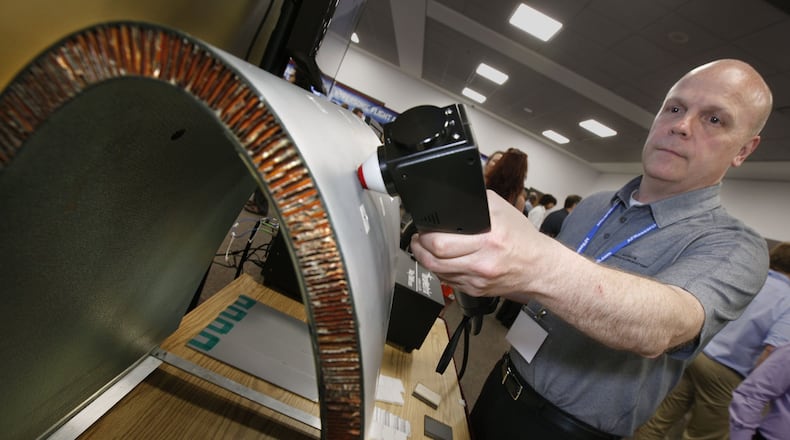Filling the jobs that will be left open by the coming retirements and taking care of employees is “critical,” said Gen. Arnold Bunch Jr., commander of the Air Force Materiel Command at the Ohio Defense Forum in Columbus on Tuesday.
» RELATED: Wright-Patt could add 5K jobs in next five years
“That’s one of my top priorities…Our workforce is critical,” Bunch said. “I get the privilege of working for 80,000+ Airmen across Air Force Materiel Command and I work for them. They are the key to us being successful and there’s a lot we need to do in those areas.”
At the Air Force Research Laboratory alone, around 36 percent of employees are already eligible to retire, said Jessica Salyers, deputy executive director of AFRL.
Further complicating things at AFRL is that nearly 70 percent of the lab’s workforce has at least a master’s degree, if not a doctorate, Salyers said.
Just 10.2 percent of Ohioans 25 and older have an advanced college degree, according to a U.S. Census estimate from 2017, the most recent year for which data is available. Ohio is also undergoing a demographics shift that will result in 13,000 fewer high school graduates in the state by the year 2032, according to the Western Interstate Commission for Higher Education
It’s those statistics that Salyers said are “keeping us up at night.”
“We’re kind of at this unique place where we’re sort of taking a look and saying: OK mentoring is really important (and) we don’t want us to succumb to brain drain, what do we need to do to make sure that we’re ready for the future?” Salyers said.
One thing the defense industry can do to better attract new talent is to make sure students know what opportunities are available, said Michael Groeber, professor of aerospace engineering at Ohio State University. Before taking a job at Ohio State, Groeber said he worked at AFRL.
» RELATED: Dayton Development Coalition names new military, aerospace executive
Students today know what companies like Apple and Facebook do, but they don’t have a good understanding of what AFRL does and may not even know that it exists, Groeber said. To solve that problem, Groeber suggested AFRL get students involved early because that kind of involvement is what attracted him to the lab right out of school.
“Me spending time there is what made me come to Wright-Patt,” he said.
Despite the looming workforce challenges, the Air Force is making progress at filling positions faster, said Kathy Watern, executive director of the Life Cycle Management Center at Wright-Patt. The LCMC — a $238 billion enterprise — is responsible for developing and sustaining the Air Force’s weapons systems.
The Air Force, Watern said, needs to focus on recruiting unique and nontraditional candidates. For example, Watern said she hired someone away from a job on Wall Street despite the fact that she was the type of candidate the military often thinks “we can’t go after.”
Working more closely with colleges and universities has long been thought of as a solution to addressing workforce needs.
While that same kind of solution could help, the defense industry will need to approach its workforce issues in unique ways, said Cassie Barlow, president of the Southwestern Ohio Council for Higher Education and former commander of the 88th Air Base Wing at Wright-Patt.
“With our current unemployment rate and our demographic challenges right now, it’s really time for companies to think outside the box in terms of attraction and retention and recruitment,” Barlow said. “There’s so many different ways to engage…obviously from internships and apprenticeships to job shadows and career fairs…There’s just so many ways to reach into that pool.”
FIVE FAST READS
• Wright-Patt to help foster creation of flying cars for the military
• Central State trying to build on momentum from financial rebound
• Drones nearly hit planes 117 times in Ohio in 5 years
• Wright-Patt tops 30K employees for first time in 30 years
• Gov. DeWine: ‘Changes certainly have to be made at Wright State’
By the numbers
30,000: Number of military and civilian employees at Wright-Patt.
50: Percent of base employees nearing the end of their careers.
36: Percent of AFRL employees already elligible for retirement.
70: Percent of AFRL employees with an advanced degree.
10.2: Percent of Ohioans over the age of 25 with an advanced degree.
13,000: Expected decline in Ohio high school grads by 2032.
About the Author
